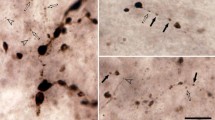Abstract
The responses of tactile hairs located on legs of the desert locust Schistocerca gregaria (Forskål) are modulated by nitric oxide (NO). There are two types of tactile hair on the tibia of the hind leg of the locust which differ in their thresholds for mechanical stimulation, their location on the leg and in the effect of NO on their responses to deflection. The spike response rates of mechanosensory neurons of low-threshold hairs decreased when exposed to elevated NO levels caused by perfusion of the leg with saline containing the NO donor PAPANONOate. In contrast, in high-threshold hairs, which show low responsiveness under control conditions, an increase in spike rates was observed during PAPANONOate application. These opposing effects of NO reduce the differences in the spike responses of the two types of tactile hairs to mechanical stimulation and are likely to have an impact on behaviours elicited by mechanical stimulation of the legs.



Similar content being viewed by others
References
Abisgold JD, Simpson SJ (1988) The effect of dietary protein levels and haemolymph composition on the sensitivity of the maxillary palp chemoreceptors of locusts. J Exp Biol 135:215–229
Annunziato L, Pannaccione A, Cataldi M, Secondo A, Castaldo P, Di Renzo G, Taglialatela M (2002) Modulation of ion channels by reactive oxygen and nitrogen species: a pathophysiological role in brain aging? Neurobiol Aging 23:819–834
Brenner R, Atkinson NS (1997) Calcium-activated potassium channel gene expression in the midgut of Drosophila. Comp Biochem Physiol B 118:411–420
Chiesa N, Rosati B, Arcangeli A, Olivotto M, Wanke E (1997) A novel role for HERG K+ channels: spike-frequency adaptation. J Physiol 501:313–318
Damann N, Voets T, Nilius B (2008) TRPs in our senses. Curr Biol 18:R880–R889
Fergestad T, Sale H, Bostwick B, Schaffer A, Ho LL, Robertson GA, Ganetzky B (2010) Drosophila behavioural mutant, down and out (dao), is defective in an essential regulator of Erg potassium channels. Proc Natl Acad Sci USA 107:5617–5621
French AS (1986) The role of calcium in the rapid adaptation of an insect mechanoreceptor. J Neurosci 6:2322–2326
Gillespie PG, Walker RG (2001) Molecular basis of mechanosensory transduction. Nature 413:194–202
Hodgson ES, Lettvin JY, Roeder KD (1955) Physiology of a primary chemoreceptor unit. Science 122:417–418
Inoue R (2005) TRP channels as a newly emerging islon-voltage-gated Ca2+ entry channel superfamily. Curr Pharm Des 11:1899–1914
Keyser MR, Witten JL (2005) Calcium-activated potassium channel of the tobacco hornworm, Manduca sexta: molecular characterization and expression analysis. J Exp Biol 208:4167–4179
Li Z, Chapleau MW, Bates JN, Bielefeldt K, Lee H-C, Abboud FM (1998) Nitric oxide as an autocrine regulator of sodium currents in baroreceptor neurons. Neuron 20:1039–1049
Liu L, Leonard AS, Motto DG, Feller MA, Price MP, Johnson WA, Welsh MJ (2003) Contribution of Drosophila DEG/ENaC genes to salt taste. Neuron 39:133–146
Newland PL (1991) Physiological properties of afferents from tactile hairs on the hind legs of the locust. J Exp Biol 155:487–503
Nie H-G, Chen L, Han D-Y, Li J, Song W-F, Wei S-P, Fang X-H, Gu X, Matalon S, Ji H-L (2009) Regulation of epithelial sodium channels by cGMP/PKGII. J Physiol 587:2663–2676
Oliver D, Taberner AM, Thurm H, Sausbier M, Arntz C, Ruth P, Fakler B, Liberman MC (2006) The role of BKCa channels in electrical signal encoding in the mammalian auditory periphery. J Neurosci 26:6181–6189
Pflüger H-J (1980) The function of hair sensilla on the locust’s leg: the role of tibial hairs. J Exp Biol 87:163–175
Philippides A, Husbands P, O’Shea M (2000) Four-dimensional neuronal signalling by nitric oxide: a computational analysis. J Neurosci 20:1199–1207
Renganathan M, Cummins TR, Waxman SG (2002) Nitric oxide blocks fast, slow and persistent Na+ channels in C-type DRG neurons by S-nitrosylation. J Neurophysiol 87:761–775
Schuppe H, Cuttle M, Newland PL (2007) Nitric oxide modulates sodium taste via a cGMP-independent pathway. Develop Neurobiol 67:219–232
Simpson SJ, Raubenheimer D (1996) Feeding behaviour, sensory physiology and nutrient feedback: a unifying model. Entomol Exp Appl 80:55–64
Simpson SJ, James S, Simmonds MSJ, Blaney WM (1991) Variation in chemosensitivity and the control of dietary selection behaviour in the locust. Appetite 17:141–154
Taglialatela M, Pannaccione A, Iossa S, Castaldo P, Annunziato L (1999) Modulation of the K+ channels encoded by the human ether-a-gogo-related gene-1 (hERG1) by nitric oxide. Mol Pharmacol 56:1298–1308
Venkatachalam K, Montell C (2007) TRP channels. Ann Rev Biochem 76:387–417
Walker RG, Willingham AT, Zuker CS (2000) A Drosophila mechanosensory transduction channel. Science 287:2229–2234
Wegener JW, Boekhoff I, Tareilus E, Breer H (1993) Olfactory signaling in antennal receptor neurons of the locust (Locusta migratoria). J Insect Physiol 39:153–163
Yoshida T, Inoue R, Morii T, Takahashi N, Yamamoto S, Hara Y, Tominaga M, Shimizu S, Sato Y, Mori Y (2006) Nitric oxide activates TRP channels by cysteine S-nitrosylation. Nature Chem Biol 2:596–607
Acknowledgments
This work was supported by an award from the Biotechnology and Biological Sciences Research Council to PLN.
Author information
Authors and Affiliations
Corresponding author
Rights and permissions
About this article
Cite this article
Schuppe, H., Newland, P.L. Differential effects of nitric oxide on the responsiveness of tactile hairs. Invert Neurosci 11, 85–90 (2011). https://doi.org/10.1007/s10158-011-0119-0
Received:
Accepted:
Published:
Issue Date:
DOI: https://doi.org/10.1007/s10158-011-0119-0




